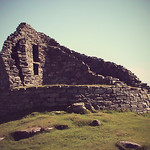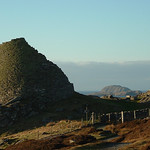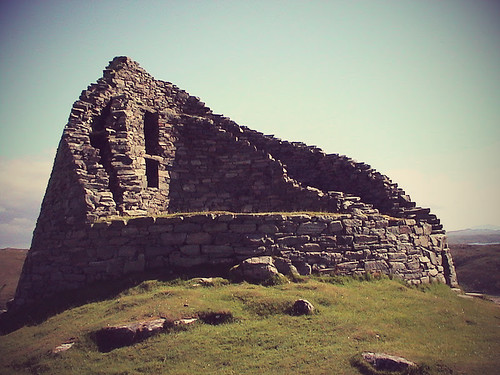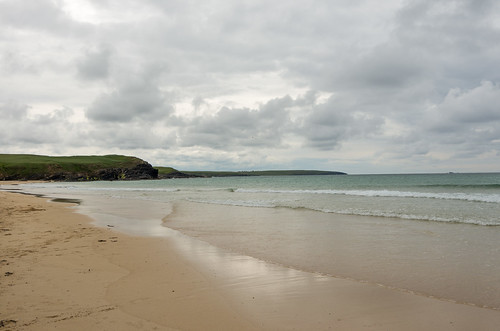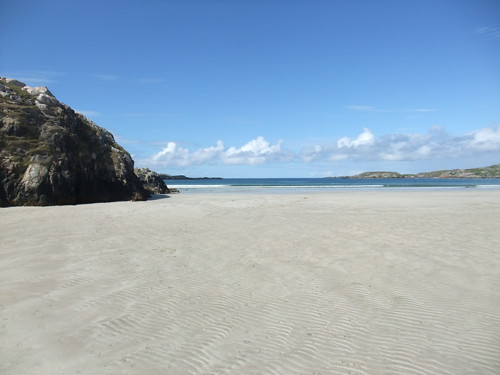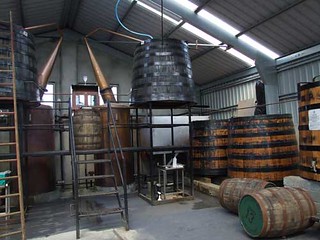Lewis West Coast
The guide to West Coast in Outer Hebrides contains information in and around the place including eating and sleeping in Lewis West Coast.
The west coast of Lewis contains most of what you'll want to see and can be covered in a day trip from Stornoway, either with your own transport, by public bus or as part of a minibus tour.
At Barabhas (Barvas) the road forks. The A857 bears right (north) and continues all the way to Nis (Ness) and the Butt of Lewis, but the road you want to take is the A858, which bears left (west). A few miles along this road is the turn-off for Arnol. At the end of the village is the Blackhouse Museum, one of the best surviving examples of an original blackhouse in Scotland and well worth visiting.
These traditional thatched houses were once common throughout the Highlands and Islands, and inhabited until the 1960s. They were built in the tradition of 'longhouses' which can be traced back 1,000 years to the time of the Viking invaders. The name 'blackhouses' dates back to the 1850s when modern buildings were introduced. These were known as 'white houses' and the older style houses were called 'blackhouses'. The blackhouses were well adapted to the harsh local climate. They had no windows or chimney and were built with local materials - stone, turf and thatch of oat, barley or marram grass, and with a peat fire burning continually in the central hearth - and attached to the living quarters was the cattle byre. This particular blackhouse was built in 1885 and lived in until 1964.
Info Tel. 44 (0) 1851 710395. Apr-Sep Mon-Sat 0930-1830; Oct-Mar Mon-Sat 0930-1630, Sun 1400-1630. Adult £2.80, concession £2, children £1.
Hebridean Replicas (Tel. 44 (0) 1851 710562) in the village offers quality handmade Lewis chess sets from local stone, and provides a welcome alternative to much of the tacky tourist paraphernalia to be found in Stornnoway.
Two miles south of the Arnol turn-off, at Bragar, look out for an archway, formed from the jawbone of a blue whale which was washed up on the coast nearby in 1920. A few miles further on is the township of Siabost (Shawbost), where the charmingly ramshackle folk museum, which was started originally as a project by local schoolchildren, now contains an interesting collection of Hebridean artefacts.
Info Mon-Sat 0900-1800, free. Behind the museum is a campsite, Tel. 44 (0) 1851 710504, March-October.
Just south of Siabost, beside a small loch, is the sign for the recently restored Norse Mill and Kiln, which are a half-mile walk over the hill from the car park. There's not much to see as yet, but it's worth getting out of the car if you want to stretch your legs. A little further on is the turning for Dail Beag (Dalbeg), a lovely secluded beach.
The landscape gradually becomes more undulating and scenically interesting as the road then passes through the village of Càrlabhagh (Carloway), Lord Leverhume's proposed fishing port. Here, a branch road leads to the ruined and deserted 'blackhouse' village of Gearrannan (Garenin). The old village has been undergoing extensive renovation in recent years with the aid of EU funding, and several derelict crofts have now been painstakingly restored to their original style of stone walls and thatched roofs. An old cart track leads down to the bay and wonderful sunsets out at sea.
The village now boasts a Gatliff Trust hostel, heritage centre, café and holiday dwellings. Above the village a footpath can be followed through the lazybeds and above the sea cliffs to reveal a stunning view of beautiful Dal More Bay. The Atlantic waves seem to break relentlessly on golden sands and the beach is, not surprisingly, the favourite haunt of the surfing jet-set from Stornoway. Swimmers and bathers should be careful, however, because as with many of the west coast beaches there can be a fierce rip-current carrying the unwary into deeper water out at sea.
A little further on, standing a few hundred yards from the main road, is the Dùn Chàrlabhaigh (Doune Carloway) Broch, the best-preserved building of its type in the Outer Hebrides. The impressive 2,000 year-old drystone habitation is beautifully situated on a rocky outcrop, commanding great views across Loch Carloway to the sea beyond.
The remaining outer wall is 30-ft high and slopes inwards, with an inner wall which rises vertically, leaving chambers between the walls. Parts of the inner wall have collapsed, revealing the interior stairs and galleries. There's also the Doune Broch Visitor Centre by the car park, which tastefully complements the architectural style of the site, and which gives a good audio-visual description of how life must have been in one of these structures around 50 BC.
Info Tel. 44 (0) 1851 643338. Doune Broch Centre Apr-Oct Mon-Sat 1000-1800. Free.
Eating Out
Overlooking a small lochan surrounded by hills beside the car park is the Copper Kettle, Tel. 710592, an unassuming little house which is actually a superb restaurant. Meals must be booked at least 24 hrs in advance and are moderately priced (last booking 2000). Open 1030 till 1730 for tea, coffee, snacks and home baking (all year Mon-Sat). Next door is a self-catering bungalow for rent (same phone number).


